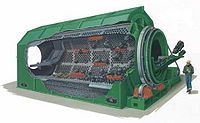Bradford Breakers
Bradford Breakers are used for crushing, sizing, and cleaning run-of-mine coal and other friable materials. They are used to produce a product that is relatively coarse, with minimum fines, and that is 100% to size.
Components
The drive assembly is uncomplicated and trouble -free, allowing the use of a single, normal starting – torque motor. Because of the high strength of the cylinder, these units are driven from one end only. This eliminates the need for an additional jack shaft to balance the torque and to drive both ends of the cylinder. Most important is the method in which the screen plates are fabricated and mounted. These we lap mount and double bolt, giving them great strength and rigidity. These plates are made on numerically- controlled equipment to such precision as to be fully interchangeable throughout the cylinder. This also enables them to be installed more easily in the field with no troublesome fit problems.
Operation Principles
Bradford Breaker consists of a large rotating cylinder powered by an electric motor through a reducer drive and chain. Coal is fed through one end of this cylinder. As it falls to the lower portion of the cylinder, sized coal quickly exits the cylinder through the sizing holes of the screen plate. Unsized coal is lifted by a series of short shelves affixed to the screen plates that form the cylinder. As those shelves rotate upwards and pass through a given angle near the top of the arc, the coal slides off and impacts against the screen plate at the bottom of the cylinder. Repeated lifting and dropping occurs until the coal exits through the holes in the screen plate. Because such gravity impact induces breakage along natural cleavage fractures, there is very little production of fines. Cleaning occurs simultaneously because any material that resists breakage – such as rock, slate, tramp iron or timber – is retained within the cylinder. Internal deflectors, together with the lifting shelves, are angled so as to induce material to flow from the feed end of the cylinder to its far end. Unbreakable foreign objects all flow to the far end where they are scooped out by an integral plow. The coal is thereby cleaned of unwanted material as it is being sized.
